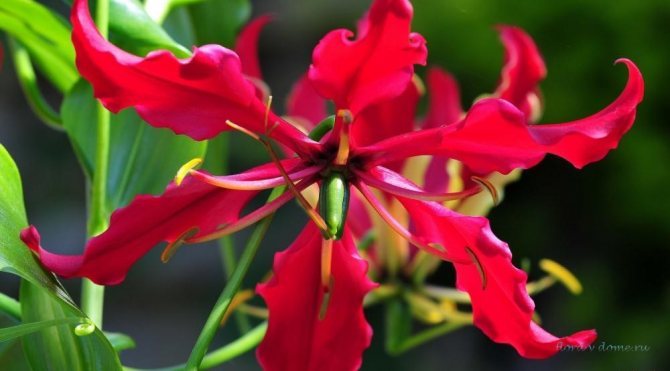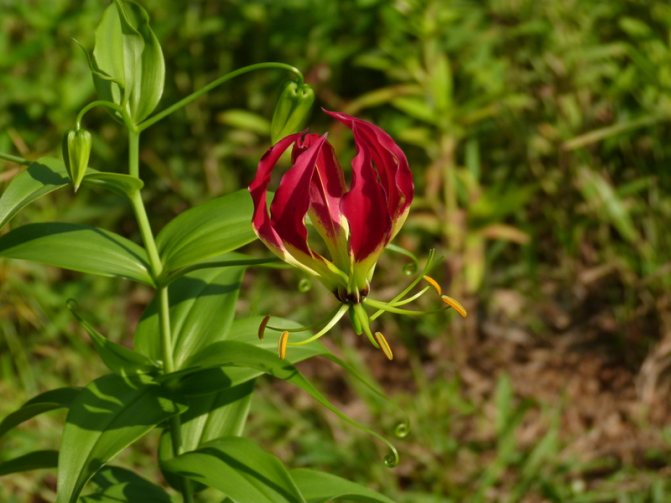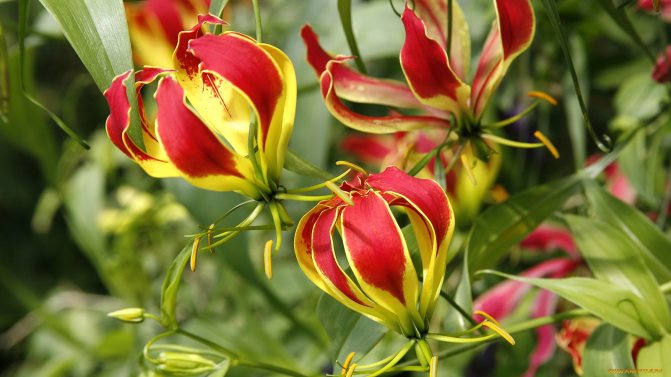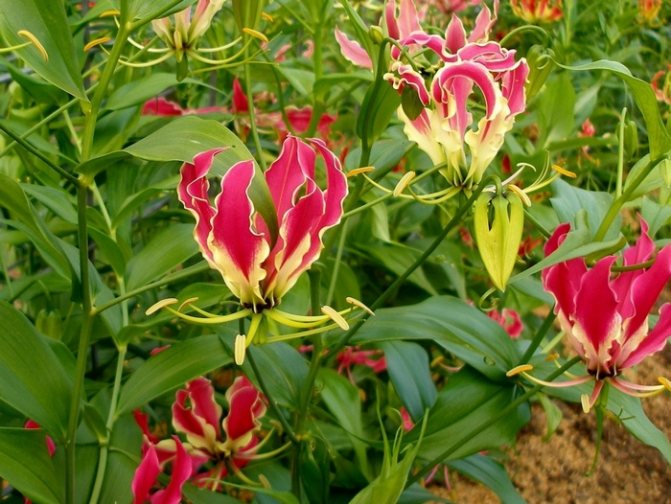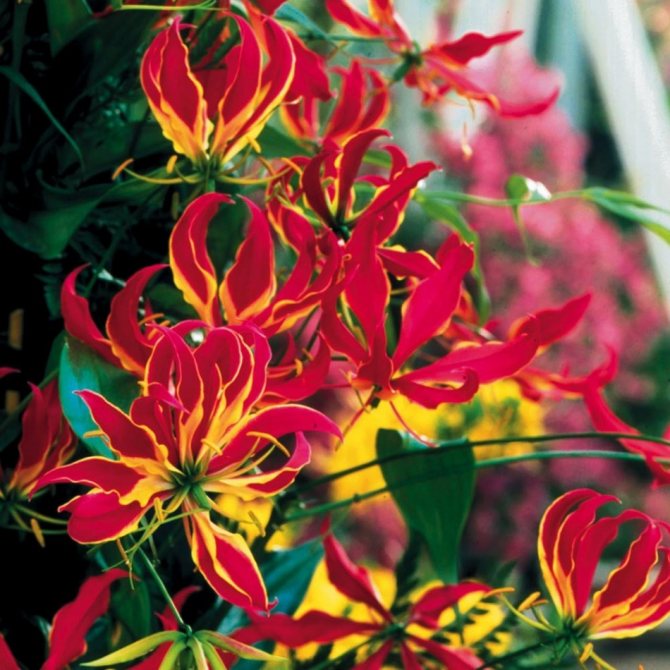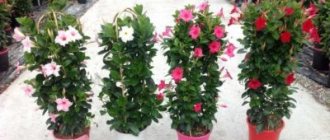This plant has many names. Some call "Fiery flower", due to its variegated color and shape, reminiscent of tongues of flame, as well as habitat in tropical climates. Others "The Queen of Blooming Lianas", thanks to flexible shoots and bright greenery. Still others say that gloriosa - heart of africa.
Description of the plant
Gloriosa (from the Latin "Gloriosus" - glorious, illustrious) Is a herbaceous perennial with a tuberous rhizome. Shoots are flexible, thin and very fragile. They cannot curl, but they have large, bright green, flat, with a pointed tip, which are called lanceolate leaves. However, it belongs to the climbing vines.

The plant grows no more than 3 m... Arrangement of leaves three in a row or opposite each other. The buds grow on a long stem and are double-colored. They bloom in the cavities of the upper leaves.
What is special about this plant?
A bright representative of the Melantiev family. The natural habitat climate is the tropics. Found in Asia and southern Africa. As a houseplant, gloriosa is grown in countries and regions with cold climates. The name "flower of glory" is often found, derived from the translation of the Latin name.
Grows from tubers. Shoots are thin, long, easily climb on supports, holding on to them with antennae. The leaves are oblong, rich in color. The location is opposite, less often - 3 pieces each. Peduncles appear from the axils of the leaves. Each has 2 flowers. The flowers resemble lilies. Bright orange perianths reach 10 cm. At the edges they are framed with a yellow border.
There is a popular name - "lily of flame". Its flowers gradually turn from yellow to red and, indeed, resemble tongues of flame during a gust of wind. Long-lasting flowering, with good care from spring to autumn. As some bloom, new buds appear. 4-7 buds are formed on each stem.
Description of the gloriosa flower and its types
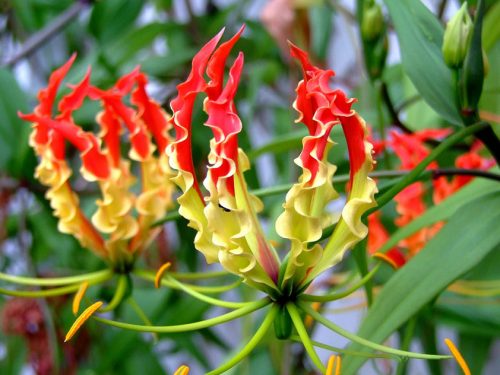

The Latin word "gloria" means "glory", so the name of the flower can be translated as "flower of glory", "glorious flower". Well, the word "lily" was not in vain in this nickname either: the gloriosa petals look like lily petals.
The historical homeland of all gloriasis is the warm tropics of Asia and Africa. Botanists have counted only 9 to 12 species in this genus, and there is still debate: to which family should the genus gloriasis be attributed? The British taxonomic school classifies it as a crocus family, while according to other reference books, it belongs to the melantia family.
All glorioses are climbing vines with long, up to 2 meters, shoots. Shoots grow from the underground tuber, and after the growing season, the entire aboveground part completely dies off. The tuber remains in the ground to winter in order to revive again in the spring with fresh, powerful stems. (Plants with a similar life cycle are called tuber geophytes.)
Gloriosa leaves are bright green, elongated and shiny. At the ends of the leaves there are antennae, with the help of which glorioses cling to natural supports. It is interesting that only thin twigs should act as a support: gloriosa "does not know how" to wrap around thick trunks, as other vines often do.Usually the foliage is located opposite, but there are species in which the leaves are arranged in three pieces.
The wealth of gloriosa is its flowers. They are attached to long peduncles that grow from the axils of the uppermost leaves. Long petals are always two-colored: crimson in the middle, often bright red, and orange, yellowish at the edges. This play of yellow and red, and even in combination with narrow, wavy petals, clearly reminds the viewer of the play of tongues of flame, which gave rise to the popular nickname that we have already mentioned.
Large flowers of gloriosa droop under their own weight, and the perianth bends upward. For this reason, the blooming gloriosa resembles a strange mixture of bell and lily.
Interesting! It is noteworthy that as the flower ages, the yellow color fades, and the red, on the contrary, becomes even brighter. Thus, an experienced eye will immediately determine whether the gloriosa has bloomed a long time ago, or very recently.
Gloriasis types


In popular flower literature, you can often find information about many types of indoor plant gloriosa. Unfortunately, it is not entirely correct. The fact is that ordinary amateurs usually have only one species: D. Magnificent (or luxurious) (Gloriosa superba)... The rest of the numerous names are either separate varieties of this species, or its synonyms.
Much less often found in apartments (and even then mainly among inveterate amateurs, almost professionals) two more types: G. Modesta (Gloriosa modesta) and G. yellow-green (Gloriosa flavovirens). Modesta is distinguished by ovate-lanceolate leaves and yellow-orange flowers that resemble bells. In addition, its tuber strongly resembles the horn of an animal, which is not observed in other gloriasis.
And here flavovirens - a real Thumbelina in the genus Gloriosa! The length of its shoots rarely exceeds 30 cm! This baby grows exclusively in Angola.
Among the popular indoor gloriasis, the most common are the following:
- Gloriosa Rothschild. As already noted, it is often positioned as a separate species, although in fact it is a widespread variety of G. the Magnificent. It is distinguished by its large size (leaves up to 17 cm long), as well as the fact that the lower part of the petal in the flower is completely yellow, while the upper one is crimson, even red.
- Gloriosa Carsoni... One of the varieties of G. Magnificent. The shoots are shortened, from 1 to 1.5 meters, and in the color of the flower chocolate and lemon-yellow colors are mixed.
- Dloriasis Yellow... Very similar to the previous variety, but the flower petals are almost completely lemon yellow.
- Dloriosis Gren... It differs in the shape of the petals: they are not wavy, as is usually the case with all gloriasis, but straight.
Gloriosa species
Gloriosa luxurious or magnificent (gloriosa superba)
Grows in clay soil. Shoots reach up to 2 m.


The leaves grow 3 pieces on one stem measuring 10x3 cm. The flowers are red, wavy, the border of the flower is yellow. Petals curves up to 8x2.5 cm.
Gloriosa simplex
This type of flowers reaches a height of 3 m.


The stems are long, thick and branched. The bud has 6 even petals with wavy edges up to 5 cm. The color is yellow-green.
Gloriosa Rothschild (gloriosa rothschildiana)
The stem is straight, large, but curls with age.


The leaves are flat with a pointed tip up to 8 cm. The petals are bent, wavy. The color is from pink to bright red, the base is yellow.
How to properly grow an exotic flower
It is not easy to be the mistress of this exotic plant, but if such a decision is made, then it is important to know the basic rules for planting and caring for a plant at home. After all, the one who once acquired a flower will never regret it.
Planting recommendations:
- The rhizome of a plant is either a root or a tuber. Be careful when handling it.Try not to break its round white tip. Since it is he, in the future, serves as a place for the formation of a bud and an escape.
- For planting gloriosa, it is better to choose a pot with a diameter of 15-17 cm and a universal soil.
- In the future, the support that is used for climbing plants will come in handy. Gloriosa is a plant that clings to a support with its tendrils rather than winds around it. Gloriosa is advised to tie up, as she can even cling to the curtains. The support helps to cope with the rapid growth of the plant. For example, Gloriosa Rothschild can reach two meters in height.
Interesting facts about gloriasis
- In the wild, gloriosa is highly adaptable to changing climates. Preferring warm and humid climates, it can hibernate slightly during the dry season. As soon as the weather changes, gloriosa "wakes up" again.
- In Australia, gloriosa, despite its fragile and delicate appearance, has supplanted a large number of plants, filling a huge space. The plant has been recognized as an invasive weed.
- Exotic gloriosa has a rather wayward character. It turns out that almost all parts of this ornamental plant contain a very dangerous poison - the alkaloid colchicine. The largest amount of this poison is concentrated in the seeds and tubers of the plant. In Australia, where gloriosa has become a real weed, local animals are regularly affected by this dangerous flower for food.
- Gloriosa is extremely popular in India. Local healers actively use this flower to prepare various recipes for traditional medicine.
- Ancient people respected gloriosa very much and went in search of this plant in the forest. Of course, it was not the decorativeness of the gloriosa that attracted them. The natives needed tubers, from which poison was extracted to wet the arrows.
- The African peoples had an interesting omen associated with gloriosa. It was believed that a warrior who took a flower with him to the battlefield would become invincible. Such an exotic plant can be safely presented to a man to emphasize his will to win and masculinity.
- Gloriosa became famous in Europe after one case. During a trip to Southern Rhodesia, Princess Elizabeth II was presented with a charming gift - a brooch in the form of a fiery gloriosa. Since then, the plant has become a favorite for home growing.
- Gloriosa is the national flower of Zimbabwe, and in some regions of India and Thailand is part of the state emblem.
- Gloriosa is a poisonous plant, so you should carefully grow it at home. Even a simple touch of a flower can cause an allergic skin reaction. If there are children or pets in the house, then it is better to refrain from growing this impudent beauty at home.
- Gloriosa is also grown for cutting bouquets, which can maintain a fresh and beautiful appearance throughout the week.
Features of growing gloriosa at home
Location and lighting
Gloriosa is a thermophilic plant and even home conditions must correspond to natural habitat conditions.


The plant is comfortable in the sun or in bright, diffused lighting. Direct sunlight destroys him. In summer, it can be transferred to an east or south windowsill, balcony or garden. In winter, it is placed in a greenhouse or garden, where there is artificial lighting close to sunlight. If the flowers were without lighting, they are gradually accustomed to sunlight or artificial lighting.
Possible difficulties
When growing gloriosa at home, a beginner a florist may face the following difficulties:
- The slow development of the plant is observed with improper storage or lack of sunlight. For the same reasons, the culture does not bloom at the right time.
- Lack of moisture can lead to yellowing of the leaves of the flower;
- The slowdown in liana growth occurs through the influence of drafts, as well as as a result of sudden temperature changes;
- If the gardener flooded the soil with water, then the plant will become lethargic, the root part begins to rot.
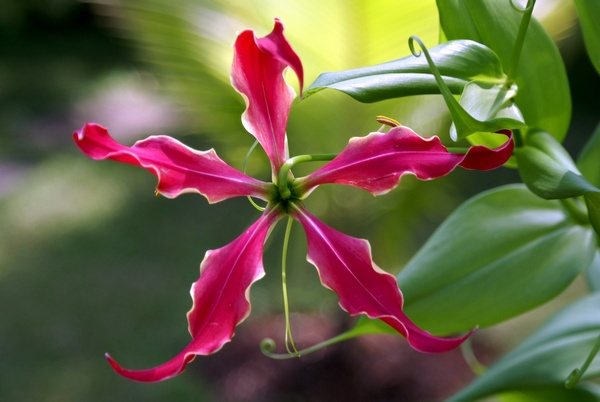

To prevent the negative effects of diseases and pests, you need to constantly monitor the crop, collect parasites or treat the leaves of the plant with insecticides. Learn how to properly care for gloriosa and it will delight you with beautiful, abundant flowering.
Care rules
For beginners, growing and caring for a flower can seem daunting. It is recommended to take into account the characteristics of the plant and adhere to a number of rules.
- Temperature. Heat-loving flower - gloriosa is comfortable at 20-22 ° C during growth and flowering. Temperature drops are undesirable. With the end of flowering, the life cycle of the plant also ends - the aboveground part completely dies off. It is cut off, the tubers are stored.
- Lighting. Optimal - diffused light. It grows well on any windows except the northern one. In the south, on hot days, it is recommended to slightly shade.
- Watering. Water until the soil is completely wetted. Between waterings, wait for the soil surface in the pot to dry out. Yellowing of leaves is a signal to reduce watering. In winter, the tubers are kept dry.
- Top dressing. Liquid products for flowering crops in the dosage specified by the manufacturer.
- Humidity. Within 60-70%. Spray in the morning and evening. Use boiled water. It is recommended to increase the humidity in the room by any means possible. For example, using a special humidifier.
Transfer
Note! During intensive growth and flowering, the crop sucks out a huge amount of nutrients from the soil, which leads to the depletion of the land. For further active growth, an annual transplant of gloriosa is required.
The plant comes out of dormancy in the last decade of February or early March. During this time, the grower should carefully examine the tubers. The transplant is performed at the first sign of kidney awakening.
Such work must be carried out with special care so as not to accidentally damage the delicate buds and fragile root. Broken or cracked vegetative parts will no longer heal.
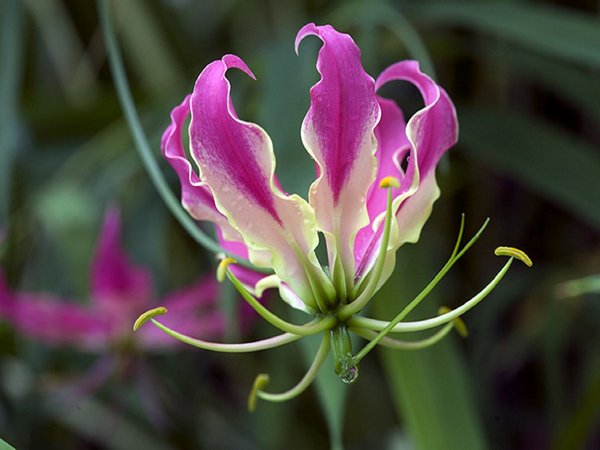

It is best to transplant gloriosa into a shallow but wide flowerpot with a diameter of 15 ... 17 centimeters. During the movement of the plant, the root part is buried 3 centimeters into the substrate, while the flower bud should look up.
The nutrient substrate for the culture is prepared by mixing the following components:
- 2 parts of leaf and sod land;
- 1 part peat;
- 1 part perlite or sand.
Before transplanting, you need to place a drainage in a flowerpot, then lay the roots of the plant and squeeze the soil. After moving to a new container, the plants are tied to a support.


Top dressing and fertilization
So that feeding and fertilization does not lead to empty results, attention should be paid to the soil before planting or transplanting. Leafy earth + humus with the addition of peat and sand in a ratio of 2: 1 is ideal. Drainage is recommended to avoid root rot. Stones, such as expanded clay or pebbles, are added under the soil layer, and then soil is added.
Gloriosa prefers liquid organic and mineral fertilizers... Alternatively, fertilizer for indoor plants "Ideal", "Uniflo - bud". Divorced according to the instructions. Florists recommend alternating mineral dressing for domestic plants with the same mullein infusion or bird droppings. The soil is fertilized in the spring every two weeks.
Gloriosa substrate and transplant
For planting and growing gloriosa, a loose and nutritious soil with a neutral PH level is suitable.The necessary soil can be obtained by mixing humus and leafy soil in a 2: 1 ratio or turf and leafy soil with peat in a 1: 1 ratio, you can also get a substrate for gloriosa by mixing 1: 1 soil for palms and roses. In order to achieve the necessary looseness of the substrate, you can add coarse sand or perlite to it.


Unlike other indoor plants, gloriasis requires a complete soil change when transplanting. Transplant it after the wintering period in late February or early March. When transplanting, be sure to remember that the flower does not like tall and plastic pots, it is best to choose a wide, ceramic pot, at the bottom of which at least 5 centimeters of drainage must be laid.


Reproduction of gloriosa
Gloriosa is propagated by tubers and seeds.
Reproduction of gloriosa tubers
In February, daughter tubers are taken out of the ground or sand and planted in pots with a diameter of 13-15 cm, sprinkling them with soil 2.5-3 cm.This must be done carefully, since the tubers are very fragile. Make sure that the growth bud is directed upward. It is best to use the bottom heating to a temperature of 20-25 degrees.
When the plant grows, and its roots fill the entire pot, transfer it to a larger bowl. You need to guide and tie the stems to the support as soon as they grow a little.
Reproduction of gloriosa by seeds
In order for the gloriosa to have seeds, it must be manually pollinated with a cotton swab or brush. Immediately after collecting the seeds, they are sown in light soil and placed in a greenhouse with supplementary lighting and bottom heating.
The seeds will need 4 months to germinate, and they will bloom in the third year. When three pairs of leaves appear, young plants are planted in small pots with a diameter of 6.0-7.5 cm.
Garter
Due to the rapid growth and fragility of the stems, the plant needs a garter. Due to weak antennae, the flower is deprived of the opportunity to reliably catch on to the support, which as a result leads to breakage of the stem or bud.


Use a plastic mesh or bamboo lattice as a reliable support.... It is attached to a pot or rail near the plant. Alternatively, stretch the string and secure the shoots to it. The use of a regular pencil or other structure that is stuck into the pot leads to root trauma and death of gloriasis.
DTo stimulate branching and enlargement of buds, shoots are not cut or split, but should be tied up with woolen thread or jute. When the stem reaches 70 - 80 cm, bend the tip down.
Advice! It is recommended to plant flowers in pots without a garter, so they will grow below, and not grow up.
Optimal microclimate for a flower
The homeland of gloriosa is tropical rainforests. Therefore, the microclimate of modern apartments is rather unusual for her. Creating optimal conditions for the plant is a prerequisite for regular flowering.
Theoretically, gloriosa can be grown as an ampelous plant, but even in this case, the problem of fragility of the shoots remains. Long stems are more likely to break under their own weight.


Gloriosa needs support - it supports fragile stems and helps the plant not to "creep"
Table: how to create suitable conditions for gloriasis
| Factor | Recommendations |
| Location | Sill of a window facing west or east. The southern window is suitable if the plant is shaded during the maximum solar activity in spring and summer. It should be possible to regularly ventilate, but without sharp cold drafts and warm air flows from the kitchen and bathroom. In summer, the flower can be taken out on a closed balcony, terrace, veranda. |
| Lighting | Natural light, bright but diffused. After a dormant period, the flower is gradually accustomed to summer conditions.The aboveground part of the plant completely dies off in winter, so the flower does not need illumination at this time. Gloriosa reacts negatively even to light partial shade. |
| Temperature | From early spring to mid-autumn - 20-25 ° C. During the rest period - 10-12 ° C. At temperatures above 15 ° C in winter, the mechanism of flower bud formation is disrupted. Temperature stability is very important. The transition from winter coolness to warmth and vice versa should be as smooth as possible. |
| Air humidity | The minimum permissible indicator is 60%, the optimal one is 70–80%. The plant needs abundant frequent spraying of the leaves, while it is desirable that the water does not get on the flowers. The soil in the pot is covered with wet moss or coconut fiber, pebbles or expanded clay are poured into the pallet. A special humidifying device can be placed nearby. Gloriasis is removed from the working radiators. |
| Support presence | The stem of the gloriosa is thin and fragile, so it is handled with great care. It is tied to a thin wire, since the leaves with antennae in its lower part are absent. The liana will not curl around the massive support, it can only cling to the structure. During the active growing season, the stem grows in length up to 1.5–2 m, so it is necessary to carefully bend it down (twist around the support), restraining growth. |
Gloriosa during dormancy How to care after flowering
Like all deciduous plants, gloriosa begins to shed its leaves with the arrival of autumn. During this period, it is necessary to help the flower, prepare it for the winter dormant period. For this, the tubers of the plant, which have formed during the growing season, are dug out of the flower pot, transferred to a moist sandy substance and stored in a dark place, maintaining the air temperature in the range from 14 to 16 ° C. Some people use a refrigerator to store tubers.
If there is no sand, then they are stored in their own pot, in the same soil, but the required storage temperature is maintained.
- Beginners need to know that in the first year of a flower's life, green leaves do not fall off. The plant begins to shed leaves from the second year. Therefore, the plant is transferred directly in the pot to a cooler room. It can be a balcony or loggia.
- If, after the first year of life, the flower has dropped its leaves, then this is a signal that additional measures must be taken to preserve young tubers. To do this, they change the soil and rarely moisten it throughout the winter in order to prevent drying out of young tubers.
If you do not apply occasional watering, gloriasis may not wake up. In no case should sawdust or sphagnum be used to store the roots. Even if all these conditions are observed, with the arrival of spring, the following feature of the flower can be noticed: a young plant wakes up earlier than an adult. And this is the norm for a flower.
Flowering features and problems
Gloriosa usually blooms from June to September. Each flower lasts about two weeks, and a new one comes to replace it. Therefore, the plant retains its attractive appearance for a long time.


Blooming gloriosa
Why gloriosa does not bloom:
- lack of sunlight;
- drafts;
- poor-quality soil, depleted in nutrients;
- improper wintering, for example, at too low temperatures;
- disease or damage to the tuber.
Activity and rest
The period of activity begins with the arrival of spring, when the tubers are planted in the soil. With proper care, the first flowers will appear at the beginning of summer. In September, they wither, gradually wither and fall off the leaves. In a young plant, the aerial part of the plant may not die off in the first year. Then you do not need to dig up the tubers, you should continue to care for the flower, reducing watering and providing warmth and light.
Types and shape of flowers
Different types of gloriosa differ in appearance. The shape of the petals is preserved, but they are not similar in size, length, edges, but always thin and elongated. Their color changes from yellow to scarlet.There are petals of purple color, pale pink, orange. The buds themselves differ in size, some reach 10-15 cm in diameter, others do not exceed 3 cm.
Breeding and planting methods
You can buy a young plant of gloriosa at a flower shop, you can dilute it with tubers, and for those who are not looking for easy ways, sowing with seeds is possible.
When planted with seeds gloriosa will bloom only for 3 years. If you agree to wait so long, then the seeds are soaked in water for a day and sown in moist soil no deeper than 0.4 cm.Ceramic pots, a drainage layer is required, the soil mixture is purchased universal or sod soil, peat and sand must be mixed in equal amounts. On top of the planting, it is necessary to cover with a film to create a greenhouse effect, but once a day they need to be ventilated and at the same time sprayed on the ground. It may take 2 months before the sprouts appear, warming or warming up the bottom of the pot will accelerate their growth. Optimal conditions are 25-27⁰С.
To propagate the gloriosa flower tuberous way, you need to separate the children and put them in one pots or immediately in separate ones. In the first case, the nodules are planted slightly obliquely so that the growth buds look in different directions, and in the future the plants do not interfere with each other. You can cut the tuber itself into pieces according to the principle of a potato and plant, but be sure to sprinkle the slices with charcoal. Children or tuber fragments are planted in ceramic pots with a diameter of 12-15 cm in a loose and nutritious soil mixture. Do not water until sprouts appear, heat the containers from below at 22-24⁰С.


Gloriasis requires a dormant period, which begins in September with the yellowing of the leaves. Plants are transferred to dry conditions, and when the shoots dry up, they dig up the tubers, place them in the sand, then in a paper bag and send them for storage in a refrigerator at 8-12⁰. You can leave gloriosa in pots if there is a dark, cool and dry place with a temperature of 16-18⁰. In both cases, the transplant is carried out in February-March, but after the refrigerator, the growth shifts by 2 weeks.
The gloriosa flower needs a yearly transplant to stimulate bud awakening, and it needs a complete land replacement. The tuber is placed strictly horizontally, from the top to the surface of the earth, 2-3 cm are left. All parts of the plant are very fragile, therefore, the bud and roots must be handled very carefully - it can die from the slightest damage.
Diseases and pests
Gloriasis disease begins with the influence of unfavorable factors. Such as:
- insufficient lighting;
- planting a damaged tuber;
- low or high air humidity, as well as exceeding the irrigation rate;
- temperature drop;
- drafts.
If symptoms of the disease are detected, it is necessary to eliminate the source, then the plant will recover.
| Symptoms | The reasons | Decision | |
| 1 | Slow growth and lack of flowering | · When planting, a damaged tuber was used; · Violation of storage conditions during the rest period; · Damage to the stem; · Insufficient lighting. | Diagnostics of the color condition is carried out. If the problem is lighting, growth will resume after solving. If it's a tuber, it is necessary to separate the diseased root from the healthy one in order to prevent the death of the plant. |
| 2 | Slow growth, darkening of leaves |
| Check the room temperature and reduce watering. |
| 3 | Yellowing of leaves |
| Increase air humidity or watering volume. |
| 4 | Sluggish, soft shoots, drooping leaves with yellowness at the base |
| Provide drainage and drying of the soil. |
As for pests, gloriasis is afraid of ticks, scale insects and aphids. The problem is solved by prophylactic spraying with chemical solutions to repel and destroy insects.If damaged by parasites, the plant must be processed and the healthy tubers or stems must be separated from the damaged ones.
Reaction to florist errors
The main sign that something does not suit gloriosa is the lack of flowering. But there are other signals that are simply obliged to alert the grower and make him think.
Table: How Gloriosa Reacts to Care Errors
| What does a plant look like | What is the reason |
| The leaves are covered with whitish drops, similar to dew. | Gloriosa is watered too abundantly, while the room temperature is high. |
| White bloom on leaves and buds. | The flower is watered with hard and / or cold water. |
| Shoots grow slowly, soften, leaves darken and numb. | The plant stands in a cold draft. Another possible reason is sudden changes in temperature. |
| Shoots and leaves turn yellow, leaf tips dry. | The flower is watered too rarely and / or moderately. The situation is further aggravated by low air humidity. |
| The plant does not bloom. | Gloriosa transplanted into a pot that is too large. |
| Gloriosa does not bloom, it grows very slowly. | The most common reason is a lack of light. Or the tubers were damaged during the transplanting process. |
| The bases of the shoots and leaf petioles turn black. | Rot develops due to regular waterlogging of the soil, especially in combination with low temperatures. Another reason is unsuitable, too heavy soil and / or lack of drainage. |
Popular decorative varieties
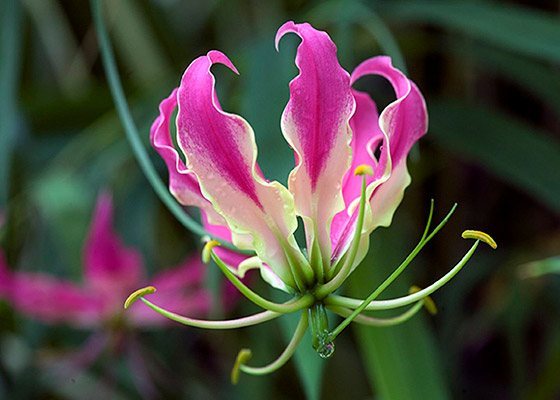

All varieties of this plant are stunningly beautiful, but only three varieties of gloriosa have gained widespread popularity among lovers of exotic plants.
- The main feature of Rothschild gloriosa is long flowering.
- Gloriosa simplea is characterized by an extremely dense flowering, but it lasts only in summer.
- Gloriosa is magnificent - from the name it is clear that this flower is of amazing beauty. True, the flowering time of luxurious gloriosa (another name for the variety) is noticeably shorter than that of congeners.
- Gloriosa ivning is also grown, but this variety with red petals is very beautiful, similar to a sunflower.
Short description
This magnificent perennial belongs to the climbing herbaceous vines. Due to the similarity with the lily, gloriosa is also called the flaming lily, and the lily of glory, and the creeping lily. In its natural habitat, the liana grows up to 5 m per season, but in indoor floriculture its growth is limited to 2 m. The gloriosa flower behaves well in cutting, retaining its beauty for up to 2 weeks.
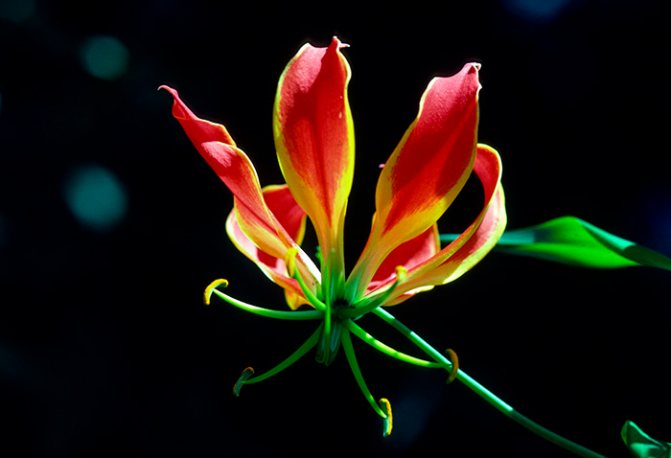

Luxury
A very spectacular and unusual liana is surprisingly beautiful not only during the flowering period. Gloriosa has bright green glossy leaves, large, with elongated antennae tips, located right at the stem, and the peduncles, on the contrary, are long and they bloom only on the upper leaves. The inflorescences drooping down and the perianth leaves bent upwards are perfectly combined with each other, and it seems that these are not petals, but long and wavy fiery tongues of shades flowing into each other, from yellow to orange-red.
Attention! Externally, the beautiful gloriosa flower contains an alkaloid that is deadly to humans. It does not cause skin irritation, but it is toxic when ingested with food, even in microscopic quantities, so you need to work with it with gloves and wash your hands thoroughly.
Among the varieties bred at home, several can be distinguished especially.
- The undisputed leadership belongs to gloriosa Luxurious (magnificent) - it has the most spectacular perianths: the lanceolate lobes are pink on the outside, bicolor inside with a yellow base and red tips. Flowering begins in June and lasts until September.
- The African Rothschild gloriosa has curly yellow-red petals. It blooms from early spring to mid-autumn.


Rothschild
- The Daisy gloriosa flower belongs to hybrid varieties - it is an annual herb, not a tropical liana, and, as you can see in the photo, only the color of the flowers is similar to true gloriosa.
- Gloriosa varieties of Santa Maria are characterized by a variety of shades and their combinations: from lemon to dark purple. Only this variety can grow in the shade, it will stand for 2 weeks in the cut and does not impose strict requirements for watering and feeding.


Daisy
Reproduction
It happens in two ways:
- Division of tubers.
- Germination of seeds.
This video shows how to plant gloriosa with tubers
Gloriosa from tubers
It is considered the fastest growing method. I separate the tuber using the cut method, which is necessarily processed with coal. It is planted bud upwards, to a depth of 3 cm. After the stalk appears above the soil, watering begins and the support is prepared.
Seed propagation
This is a long process. At least 2 years pass from the moment of planting the seeds to the appearance of the first flowering. Seeds are sown from mid-February... A pot or bowl is filled with peat with black soil and covered with thin glass. The container with seeds is placed in a ventilated room with temperatures up to 20 - 24C... The sprouts that appear are thinned out by separation and disembarkation in vessels.
In the next video you can watch the process of planting a plant with seeds.
Propagating gloriosa
Gloriosa can be propagated by seeds and tubers. There are pros and cons to each method. When propagating by seeds, it will take longer to wait for flowering, the grown seedling blooms for 2-3 years. By propagating gloriosa with tubers, you will get a blooming vine in the year of planting or the next. But the tubers of this plant are very delicate and easily damaged.
Seeds
Gloriosa seeds can be purchased, and if you already own a vine, try pollinating the flowers and getting planting material. Use a brush or cotton swab to collect the pollen from the stamens and transfer to the pistil. Do the operation on several colors to ensure the result.


Gloriosa seeds can be obtained by yourself
After the flowers wither, a seed pod will appear. Wait for it to ripen, there will be quite large seeds inside. They retain their germination capacity for up to 3 years. In the spring, start sowing:
- Keep the seeds in a biostimulator for 24 hours (in Epin or Zircon).
- Prepare the substrate: peat with sand and sod land equally, disinfect by calcining.
- Pour the soil mixture into a greenhouse container (it is good if it is heated).
- Moisten the substrate, sow seeds half a centimeter deep. Cover with a clear lid, glass, or bag. Turn on the heating, if any.
- Place the container with crops in a warm (22-24 degrees) and well-lit place.
- Ventilate the seedlings every day, and if necessary, moisten them with a spray bottle.
- Sprouts appear a month later or a little earlier. Do not transplant them right away, let them grow.
- When the shoots get stronger, they release several leaves, you can plant them in different pots.
- Then take care of young gloriasis in the same way as for adults.
The poisonous properties of gloriosa
They call it a poisonous weed for a reason. The fact is that any part of the plant contains the poison colchicine in the amount of 6 mg. The result of a full dose of poison entering the body is the death of a person or animal. Ingestion of some of the colchicine results in nausea, vomiting, kidney failure, and hair loss. In individual cases, an allergic reaction of the skin or respiratory tract is possible.
Due to the poisonous properties of gloriosa, it is recommended:
- Take care when leaving, transplanting and growing;
- Expose the pots out of the reach of children and animals to avoid accidental contact or swallowing of a part of the plant.
Important! If you experience any symptoms of poisoning, you should immediately contact a medical facility.
Mr. Summer resident warns: gloriosa is a poisonous plant
The plant has poisonous properties, so it is strictly forbidden to eat it. When it enters the esophagus, it negatively affects the gastrointestinal tract, the general condition worsens, migraines develop, nausea and vomiting are possible.
To exclude poisoning, the flower is placed away from children and pets, in their case, poisoning can even lead to death.
In case of contact with gloriosa, wash your hands thoroughly with soap, and wear rubber gloves when working with it.
Subject to all the rules for caring for a flower, it will delight you with a healthy look and beautiful flowering. The main thing is to pay attention to the quality of irrigation and fertilization.
General information
In its roots and seeds, this plant contains colchicine, an alkaloid used in genetics and medicine. It does not irritate the hands when it comes into contact with the skin, but is dangerous if swallowed in large quantities. But flower growers still recommend for safety, after performing all procedures with the plant, to wash your hands.
If you are not afraid of this fact, and the beauty of this flower is desirable, you can make it part of your home flora. Most often, some types are used for these purposes: Gloriosa the Magnificent and Gloriosa Rothschild... After all, no matter what they say about him - the appearance of his flowers, bright crimson, reminiscent of lilies, is striking.
In another article, we discussed an unusual flower - an exchange.
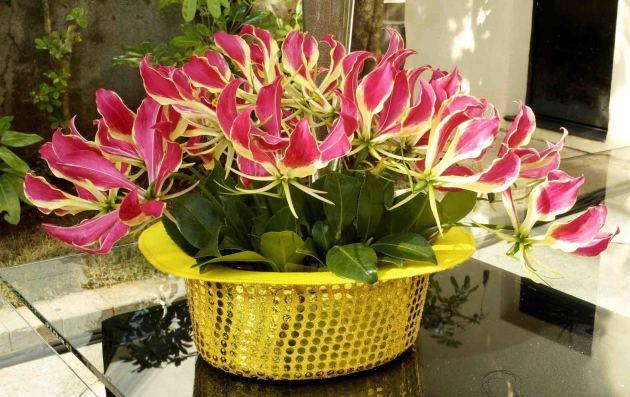

In conclusion
"Queen of lianas" or fire gloriosa - a bright decoration of any garden or vegetable corner in the apartment. She is not whimsical, but requires strict adherence to the rules and regulations of care.


Despite its poisonous properties, the plant is used in folk medicine in India, Asia and Africa. There are also preparations based on gloriosa superba (magnificent gloriosa). With the help of herbal ingredients, there is complex treatment and prevention of inflammation, gout and tumors... A colorful bouquet of gloriosa will complement the bride's wedding image or delight a woman no worse than a bouquet of roses. People say that flowers not only kill, but heal and cheer up.

